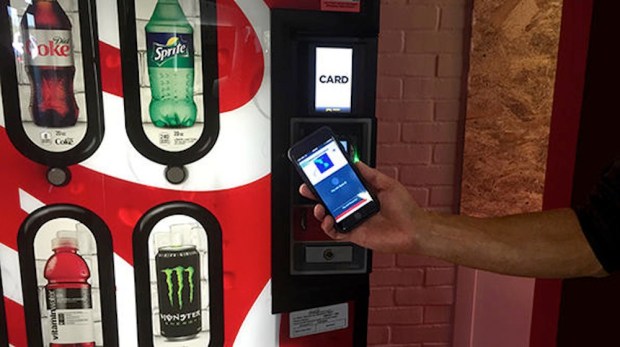How Self-Service Retail Is Becoming Mainstream Retail

Vending machines aren’t about soda and salty snacks anymore — even if, at the consumer level, that’s what most people think of when they think about the technology. And vending machine operators are behind that mental reset as they contemplate their own futures since vending machines no longer have to be about junk food bought with cash.
“The wave of vending operators that are embracing cashless and mobile continues to roll through the sector because there is a lot of evidence that consumers like it and spend more,” USA Technologies Senior Vice President of Sales and Marketing Maeve McKenna Duska told Karen Webster in a recent conversation. “We’ve been seeing [this build] over the last year and half or so, and the market is really accelerating now.”
The latest evidence of that acceleration was in the headlines last week when USA Technologies announced its latest partnership with Colorado-based Premier Services, Inc.. Under the terms of the agreement, USAT is now the company’s single cashless payments provider for all credit, debit, mobile and loyalty services for its vending, coffee and micro-market kiosks throughout the Denver region.
“The pervasiveness of the smartphone has given us a new way to engage with our customers at the point of sale, which, in turn, is giving us the data we need to foster long-term relationships. USA Technologies was the best and only choice for this journey,” remarked George Yost, president of Premier Services, Inc., in the announcement.
And it is a journey that an increasing number of merchants are deciding to take, noted Duska, and one USA Technologies is happy to keep enabling. And enabling in a variety of ways, she told Webster, because the changing payments technology in self-service retail is about more than making it easy to grab Cheez-Its on the go; it’s about making it easier to get everything.
The Increasingly Cashless Landscape
When it comes to vending, the sea change to cashless is being driven by merchants who have had the realization that only offering cash as a way to pay is a good way to lose sales, according to Duska.
But with the changing course of the market under way right now, upgrading to a better technological option also carries an ancillary benefit: the ability to be a step ahead and leverage that as part of the marketing efforts.
“The smart folks are doing it because they know they have to to stay in business because they are losing people who can’t buy at their machines. But they are also doing it because they want to set their companies up as being innovative. They want to be strategic where their competition isn’t while there is still a chance to do that. This offers them a short-term competitive edge for businesses.”
And thinking strategically, as opposed to opportunistically, about the vending business matters, Duska noted, because it is both so often overlooked and influential in the short and long term. Which is why, she noted, more than just enabling the payments services, USA Technologies is offering Premier Services marketing support because, better than just enabling a more efficient payment method for clients, it is actually telling potential customers about it.
“We offer them marketing support in locations because we’ve found that, if you just stick a machine in and do nothing, you will see an increase in sales and revenue based on new credit and debit transactions. That volume increases over time and then levels out at about month 10.”
The reason for that is simple: Ten months is about how long it takes for word of mouth to get around a location that the vending machines are now taking card and mobile payments, and customers who otherwise were never stopping — because they don’t carry cash — learn that coffee, candy or soda are a tap or swipe away.
Two years ago, USA Tech realized that it could improve on that — a lot — and began actually advertising the services. The results were pretty dramatic, with transactions up by a third in about a third the time.
“We found we could accelerate increased adoption enough that we were seeing around 36 percent in three months’ time. And when we came back a year later, they were performing 106 percent better than locations where we did no awareness at all.”
And that, she noted, is a beginning effort. For some of its partners, they are looking beyond that hyper-localized awareness to target regional awareness. “We’ve done all kinds of really interesting ideas — videos for the softball field — because we know our customers are looking to establish leadership here.”
The Bigger Opportunity
Beyond the marketing ability and the fact that the more payment methods they can take, the more customers they have a chance of capturing, the opportunity for self-service vendors is also growing and evolving.
This is especially true when one looks at the kiosks and micro-markets out there so that the customer at the vending machine can now do something they’ve not been able to do in a mostly cash-based ecosystem — tap into loyalty and rewards benefits. The vending machine customer is now trackable — and accountable. The operator doesn’t have to simply give up on this customer outside of a series of one-off interactions at a self-service vending machine because they can follow that customer throughout the course of the relationship.
And this not only pushes the boundaries of how self-service kiosk makers sell but what they sell.
“I spend a lot of time telling our partners that they are in a prime location and that that is exactly where traditional retail is trying to get to — the places where people actually are,” Duska explained, who also confirmed that the goal now is for those vending and self-service clients to meet traditional retail and brands where they do really well: technology, rewards and payments. Duska said that customer relationships, self-service kiosks and vending machines can be used to expand those brands’ reach and reputation.
And, noted Karen Webster, the evidence of that is popping up in the general retail ecosystem all the time: Snapchat releasing its Snap specs via a vending machine as part of its pre-IPO announcement buzz generation or McDonald’s recent efforts to give the world a free Big Mac — vended from a machine for the price of a Twitter handle.
“The challenge going forward for these vending brands is really seeing the full reach of the opportunity. Consumers want self-service, and brands want to offer it, and these companies have literally been doing it for 100 years.”
And now, with the advent of better payments — and an ability to turn those payments into an entire commerce relationship — they can take what they’ve been doing for a 100 years and do it bigger, broader and as a whole new way to think about physical retail.
Like we said, it’s not quite about pretzels anymore.
